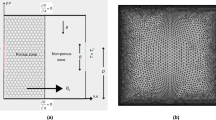Abstract
The paper presents some typical results of an analysis of two-dimensional, steady-state heat conduction in coolant channels subjected to the third kind of thermal boundary conditions usually encountered in a regeneratively or dump-cooled liquid rocket engine. Duct geometries of circular, rectangular, trapezoidal and isosceles triangular cross-sections with rounded corners are considered. The solution method is based on the boundary collocation technique of linear least-squares matching using Householder reflections.
The results of maximum duct wall temperatures and total heat transfer to the coolant by the present analysis vis-a-vis those by one-dimensional analysis reveal that the latter predicts higher values of maximum wall temperatures in the curved region of non-circular ducts and lower values of total heat transfer to the coolant.
Zusammenfassung
Die Arbeit zeigt einige typische Ergebnisse für zweidimensionale, stationäre Wärmeleitung in Kühlkanälen mit der Randbedingung dritter Art, wie sie üblicherweise bei gekühlten Flüssigkeitsraketen auftreten. Es werden kreisförmige, rechtwinkelige, trapezförmige und gleichschenkelig-dreieckige Querschnitte mit gerundeten Ecken betrachtet. Die Lösungsmethode fußt auf dem Rand-Kollokationsverfahren der linearen Anpassung mit Hilfe des Prinzips der kleinsten Fehlerquadrate unter Verwendung von Householder-Reflexionen.
Die Ergebnisse der größten Wandtemperaturen und des Gesamtwärmeübergangs nach dieser Methode zeigen im Vergleich zur eindimensionalen Rechnung, daß die letztere höhere Werte für die Maxima der Wandtemperaturen im gekrümmten Bereich der nichtkreisförmigen Kanäle und geringere Werte für den Gesamtwärmeübergang ergibt.
Similar content being viewed by others
Abbreviations
- Bi:
-
Biot number, ht/k
- fj :
-
harmonic functions in Eq.(5)
- h:
-
heat transfer coefficient
- k:
-
thermal conductivity of duct wall material
- M:
-
number of boundary points
- N:
-
number of terms in the series solution, Eq.(5) minus one
- n:
-
distance along normal to duct boundary
- q:
-
ratio of total heat transfer to the coolant based on two-dimensional and one-dimensional analysis
- r:
-
radial coordinate in the polar coordinate system
- T:
-
temperature
- t:
-
duct wall thickness
- α j :
-
coefficients of harmonic functions in Eq. (5)
- β:
-
angle between tangent to the duct boundary and X-axis
- S:
-
angular coordinate in the polar coordinate system
- η:
-
dimensionless normal distance, n/t
- ζ :
-
dimensionless radial distance, r/t
- ρ:
-
radius of curvature
- θ:
-
dimensionless temperature, (T-Tc)/(Tg-Tc)
- θ:
-
dimensionless temperature, 1 — θ
- ξ :
-
distance along duct boundary
- ε:
-
percentage error in heat balance at duct boundaries,\(|\frac{{q_r - q_i }}{{q_e }}| \times 100\)
- δ:
-
given by Eq.(13)
- Γ:
-
duct boundary
- c:
-
coolant
- e:
-
external
- g:
-
gas
- i:
-
internal
- p:
-
boundary point
- ∞:
-
fluid temperature
- (′):
-
values computed from one-dimensional analysis
- (−):
-
peripheral average value
- (−):
-
average value over part of the duct periphery exposed to combustion gases
References
Deissler, R.G.; Taylor, M.F.: Analysis of Turbulent flow and Heat Transfer in Non-Circular Passages. NACA, TN 4384, 1958
Eckert, E.R.G.; Irvine, T.F., Jr.: Pressure Drop and Heat Transfer in a Duct with Triangular Cross-Section. J. Heat Transfer, (1960) 125–138
Krueger, R.C.; Curren, A.N.: Some Factors Influencing Heat Transfer to Liquid-Propellant — Rocket — Thrust — Chamber Coolant Channels. NASA, TND-3671, 1966
Kudelya, P.P.; Shrayber, A.A.: Calculation of the Temperature Field of a Hollow Cylinder with Internal Heat Sources at Non-linear Boundary Conditions of the Third kind, Heat Transfer (1974) 112–114
Sultanian, B.K.; Sastri, V.M.K.: Steady Heat Conduction in a Circular Duct with Circumferentially Varying Heat Transfer Coefficients. Regional J. Energy, Heat and Mass Transfer (1979) 101–110
Golub, G.H.: Numerical Methods for Solving Linear Least Squares Problem. Num. Math. 7 (1965) 206–216
Golub, G.H.; Businger, P.: Linear Least Squares Solutions by Householder Transformations. Num. Math. 7 (1965) 269–276
Shah, R.K.: Laminar Flow Friction and Forced Convection Heat Transfer in Ducts of Arbitrary Geometry. Int. J. Heat Mass Transfer. 18 (1975) 849–862
Sultanian, B.K.: Influence of Geometry and Peripheral Heat Transfer Coefficients on Heat Conduction in Coolant Ducts. M.S. Thesis, Mech. Engg. Dept., Indian Institute of Technology, Madras (India) (1978)
Cheng, K.C.: Analog Solution of Laminar Heat Transfer in Non-Circular Ducts by Moiré Method and Point Matching. J. Heat Transfer 88 (1966) 175–182
Bartels, R.H.; Golub, G.H.: Stable Numerical Methods for obtaining the Chebyshev Solution to an Overdetermined System of Equations. Communications of the ACM 11 (1968) 401–406, 428–430
Author information
Authors and Affiliations
Rights and permissions
About this article
Cite this article
Sultanian, B.K., Sastri, V.M.K. Einfluß der Geometrie auf die Wärmeleitung in Kühlkanälen einer Flüssigkeits-Rakete. Warme- und Stoffubertragung 14, 245–251 (1980). https://doi.org/10.1007/BF01618356
Received:
Issue Date:
DOI: https://doi.org/10.1007/BF01618356




